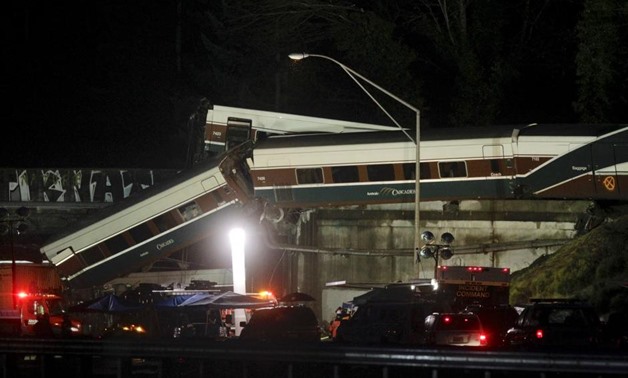
Rescue personnel and equipment are seen working into darkness at the scene where an Amtrak passenger train derailed on a bridge over interstate highway I-5 in DuPont, Washington, U.S. December 18, 2017. REUTERS/Steve Dipaola
WASHINGTON - 21 December 2017: Workers had cleared all the wrecked train cars blocking a major West Coast highway by Wednesday morning, two days after the Amtrak train derailed in Washington state while speeding onto a bridge, state transportation officials said.
It took about a day longer than hoped, but crews had carted off the biggest chunk by the afternoon: the 270,000-pound (122,470-kg) locomotive involved in the Monday morning rush-hour crash in the city of Dupont, which killed three train passengers and sent about 100 people to hospitals.
The affected southbound stretch of Interstate 5, which runs from the Canadian border to Mexico, will remain closed indefinitely, the Washington State Department of Transportation has said. Workers were clearing debris and may need to make repairs to the road surface, the department said.
Federal investigators from the National Transportation Safety Board (NTSB) are seeking answers about crash's cause in interviews with the train's engineer and a trainee conductor who were in the locomotive's cab.
NTSB members say they are focused on whether the engineer was distracted, but are timing their interviews with the crew this week around their recuperation from injuries. Investigators are also examining the wrecked train cars, which have been taken to a nearby U.S. military base.
The accident occurred during the train's inaugural run on a new, slightly quicker route between Olympia and Tacoma, with 86 people aboard, 80 of them passengers, Amtrak said. It was traveling at 80 miles (129 km) per hour, more than twice the speed limit for the curved portion of track leading to the bridge.
NTSB investigators have found that the train's emergency brakes were automatically activated during the derailment rather than being engaged manually by the engineer.
They also said a safety system known as positive train control, which automatically slows trains if they go too fast, was not installed on the rail line. Congress had extended a mandatory deadline for having the system installed on all passenger railways to 2018.
The derailment placed Amtrak, the country's main passenger rail service, under renewed scrutiny following a series of fatal incidents.
At least two of the three people killed in the derailment were transit enthusiasts who wanted to ride the inaugural run along the new route. A medical examiner is still trying to identify the third victim through fingerprints, the Washington State Patrol said on Wednesday.

Comments
Leave a Comment